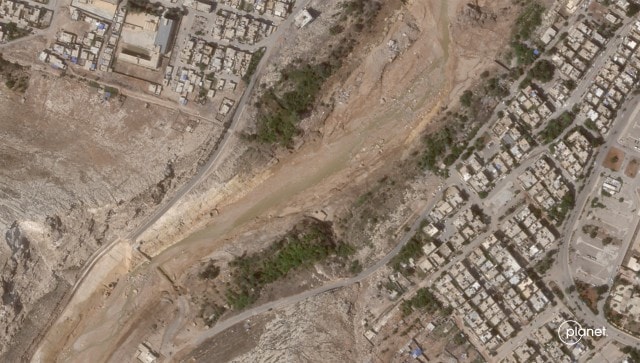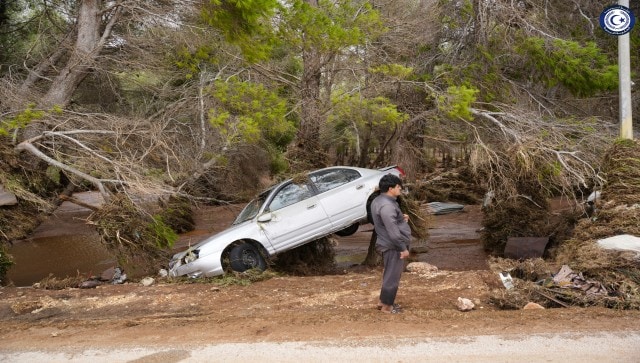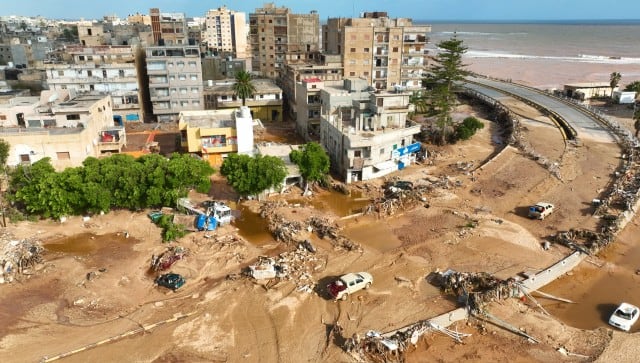Over 11,000 are dead in Libya’s coastal city of Derna and another 10,000 missing as rescue operations continue. The massive flood was caused by the collapse of two dams – built back in the 1970s – outside the Mediterranean city. Now, questions are being raised about whether the warnings about the dangerous state of the dams were ignored. The flooding, which swept away entire families in Derna on Sunday night, has exposed vulnerabilities in the oil-rich country that has been mired in conflict since a 2011 uprising that toppled long-ruling dictator Moammar Gadhafi. Let’s take a closer look: What happened? Daniel, an unusually strong Mediterranean storm, caused deadly flooding in communities across eastern Libya, but the worst-hit was Derna. As the storm pounded the coast Sunday night, residents said they heard loud explosions when two dams outside the city collapsed. Floodwaters gushed down Wadi Derna, a valley that cuts through the city, crashing through buildings and washing people out to sea.
A UN official on Thursday that most casualties could have been avoided.
“If there would have been a normal operating meteorological service, they could have issued the warnings,” World Meteorological Organization head Petteri Taalas told reporters in Geneva. “The emergency management authorities would have been able to carry out the evacuation.” The WMO said earlier this week that the National Meteorological Center issued warnings 72 hours before the flooding, notifying all governmental authorities by email and through media. Officials in eastern Libya warned the public about the coming storm, and on Saturday, they ordered residents to evacuate coastal areas, fearing a surge from the sea. But there was no warning about the dams collapsing. Why did dams collapse? As per The National News, the first damn was constructed by a Yugoslavian company in the 1970s. It was built alongside the river bed in order to control seasonal flooding.
The website of the company, Hidrotehnika-Hidroenergetika, describes it as an “embankment dam”.
The website says the dam was built with rocks and clay and work on it was finished in 1977. As per CNN, the first dam, known as the Derna dam, is 75 metres tall and holds 18 million cubic meters of water. The second dam, known as Mansour, is 45 metres tall and holds 1.5 million cubic meters of water. [caption id=“attachment_13117802” align=“alignnone” width=“640”] This satellite photo from Planet Labs PBC shows a dam collapse in Derna, Libya, on Tuesday. AP[/caption] As per Al Jazeera, the collapse of the first one resulted in the collapse of the second. The second dam had to face both the heavy rain and the water released from the first dam. The combined force was made even worse by the difference in height between the two dams. The outlet quoted experts as saying that around 30 million cubic metres of water were released as a result of the collapse. That works out to 12,000 Olympic-sized swimming pools. Al Jazeera quoted Derna’s deputy mayor Ahmed Madroud as claiming that the two dams had not been serviced since 2002. “The dams have not been maintained since 2002, and they are not big,” Madroud said. “When the river overflowed its banks, then it just took all the buildings with it, and the families that were in it.” As per The Guardian, Turkish firm Arsel was given the task of working on the dams in 2007 but fled the country after war broke out in 2011. Part of the funds set aside for maintenance work in 2003 – around 39 million dinars – were taken back from the country’s water resources ministry. A report by a state-run audit agency in 2021 noted that more than two million euros had been allocated for that purpose in 2012 and 2013. What do experts say? Some, like Malak Altaeb, a fellow at the Centre for Climate and Security, point to the lack of maintenance. Altaeb told The National News, “Dams in Libya and especially in the east of the country, haven’t received maintenance in years and management bodies haven’t provided adequate financial support and means to support the dams, which has led to adverse effects.” “Instead of protecting from flooding, the dams ended up flooding the city,” Altaeb, who studied at the University of Tripoli, added. France24 quoted a November 2022 research paper by Omar al-Mukhtar University hydrologist Abdelwanees A R Ashoor as warning that the dams required urgent attention. “The results that were obtained demonstrate that the studied area is at risk of flooding,” he wrote. “Therefore, immediate measures must be taken for routine maintenance of the dams, because in the event of a big flood, the consequences will be disastrous for the residents of the valley and the city.” [caption id=“attachment_13117752” align=“alignnone” width=“640”]
This satellite photo from Planet Labs PBC shows a dam collapse in Derna, Libya, on Tuesday. AP[/caption] As per Al Jazeera, the collapse of the first one resulted in the collapse of the second. The second dam had to face both the heavy rain and the water released from the first dam. The combined force was made even worse by the difference in height between the two dams. The outlet quoted experts as saying that around 30 million cubic metres of water were released as a result of the collapse. That works out to 12,000 Olympic-sized swimming pools. Al Jazeera quoted Derna’s deputy mayor Ahmed Madroud as claiming that the two dams had not been serviced since 2002. “The dams have not been maintained since 2002, and they are not big,” Madroud said. “When the river overflowed its banks, then it just took all the buildings with it, and the families that were in it.” As per The Guardian, Turkish firm Arsel was given the task of working on the dams in 2007 but fled the country after war broke out in 2011. Part of the funds set aside for maintenance work in 2003 – around 39 million dinars – were taken back from the country’s water resources ministry. A report by a state-run audit agency in 2021 noted that more than two million euros had been allocated for that purpose in 2012 and 2013. What do experts say? Some, like Malak Altaeb, a fellow at the Centre for Climate and Security, point to the lack of maintenance. Altaeb told The National News, “Dams in Libya and especially in the east of the country, haven’t received maintenance in years and management bodies haven’t provided adequate financial support and means to support the dams, which has led to adverse effects.” “Instead of protecting from flooding, the dams ended up flooding the city,” Altaeb, who studied at the University of Tripoli, added. France24 quoted a November 2022 research paper by Omar al-Mukhtar University hydrologist Abdelwanees A R Ashoor as warning that the dams required urgent attention. “The results that were obtained demonstrate that the studied area is at risk of flooding,” he wrote. “Therefore, immediate measures must be taken for routine maintenance of the dams, because in the event of a big flood, the consequences will be disastrous for the residents of the valley and the city.” [caption id=“attachment_13117752” align=“alignnone” width=“640”] In this photo provided by the Libyan government, a car sits partly suspended in trees after being carried by floodwaters in Derna, Libya. AP[/caption] CNN quoted a 2022 Sebha University paper as saying both dams had a “high potential for flood risk” and calling for periodic maintenance to avert “catastrophic” flooding. “The current situation in the Wadi Derna reservoir requires officials to take immediate measures to carry out periodic maintenance of existing dams,” the paper recommended last year. “Because in the event of a huge flood, the result will be catastrophic on the residents of the valley and the city.”
In this photo provided by the Libyan government, a car sits partly suspended in trees after being carried by floodwaters in Derna, Libya. AP[/caption] CNN quoted a 2022 Sebha University paper as saying both dams had a “high potential for flood risk” and calling for periodic maintenance to avert “catastrophic” flooding. “The current situation in the Wadi Derna reservoir requires officials to take immediate measures to carry out periodic maintenance of existing dams,” the paper recommended last year. “Because in the event of a huge flood, the result will be catastrophic on the residents of the valley and the city.”
But others say it is too early to determine exactly why the dams failed.
Liz Stephens, a professor in climate risks and resilience at the University of Reading’s Department of Meteorology, told France24 the dams’ failure was ‘catastrophic’ She added that keeping a close watch on the damns could have potentially made a difference. “It is too early to determine whether the failure of the dam was caused by a lack of maintenance or whether it was not designed to be resilient to the exceptional amount of rainfall that fell,” she said. “Monitoring of the condition of the dam could have perhaps supported early warning of potential failure, and precautionary evacuations of the people in harm’s way.” Tilman Roschinski, an expert on hydrology and geology at the Plan4Risk consultancy, told the outlet, “If you look at the video of the destroyed dam, you can see a reinforced concrete wall, part of which is still standing but most of it has been shorn off.” “We don’t know at this stage what the wall was designed to withstand, but it raises questions, especially on the maintenance issue, such as the quality of the concrete which can seriously deteriorate over years when exposed to water.” ‘Hold everyone accountable’ Libya’s Tripoli-based prime minister, Abdul-Hamid Dbeibah, acknowledged the maintenance issues during a Cabinet meeting Thursday and called on the Public Prosecutor to open an urgent investigation into the dams’ collapse. [caption id=“attachment_13117722” align=“alignnone” width=“640”] Mediterranean storm Daniel caused devastating floods in Libya that broke dams and swept away entire neighborhoods in multiple coastal towns, the destruction appeared greatest in Derna city. AP[/caption] The Guardian quoted Libya’s presidential council chair, Mohamed al-Menfi, as saying the inquiry should “hold accountable everyone who made a mistake or neglected by abstaining or taking actions that resulted in the collapse of the city’s dams”.
Mediterranean storm Daniel caused devastating floods in Libya that broke dams and swept away entire neighborhoods in multiple coastal towns, the destruction appeared greatest in Derna city. AP[/caption] The Guardian quoted Libya’s presidential council chair, Mohamed al-Menfi, as saying the inquiry should “hold accountable everyone who made a mistake or neglected by abstaining or taking actions that resulted in the collapse of the city’s dams”.
The disaster brought a rare moment of unity, as government agencies across the country rushed to help the affected areas.
While the Tobruk-based government of eastern Libya is leading relief efforts, the Tripoli-based western government allocated the equivalent of $412 million for reconstruction in Derna and other eastern towns, and an armed group in Tripoli sent a convoy with humanitarian aid. Hichem Chkiouat, minister of civil aviation and member of the emergency committee of the eastern administration of Libya, said a quarter of Derna has been completely destroyed. “I returned from Derna. It is very disastrous. Bodies are lying everywhere – in the sea, in the valleys, under the buildings. I am not exaggerating when I say 25 percent of the city has disappeared,” Chkiouat told told Reuters. With inputs from agencies
)